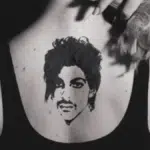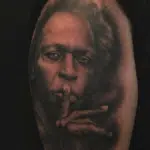A federal jury is set to decide whether celebrity tattoo artist Kat Von D infringed photographer Jeff Sedlik’s copyright in a Miles Davis portrait by tattooing the image onto her client’s body.
A first-of-its-kind copyright infringement trial begins today in Los Angeles. Like the tattoo at issue in the case, the lawsuit is poised to leave a lasting impression, not only on copyright law, but the entire multi-billion-dollar tattoo industry.
UPDATE—January 27, 2024—Kat Von D has prevailed at trial, with the jury finding that her tattoo wasn’t “substantially similar” to Jeff Sedlik’s Miles Davis photograph. Click here for more on the verdict. Want even more? Attorney Matt Neco had a front row seat for the trial and has a comprehensive breakdown here.
Photographer Jeff Sedlik will ask a federal jury to find that celebrity tattoo artist Katherine Von Drachenberg (aka Kat Von D) infringed the copyright in his iconic portrait of Miles Davis by reproducing the photo in a tattoo and then displaying images of her handiwork on social media.

I’ve been following this case since February 2021, so check out my posts (here, here, and here) if you need a refresher. The TLDR is that Sedlik owns a valid copyright in the Miles Davis photo, and Kat Von D admits to using the photo as a reference image to create her tattoo. The arm in question belongs to Blake Farmer, a lighting technician and friend of Von D’s. She didn’t charge him for the tattoo, but Sedlik contends that Kat Von D still profited because her social media posts helped to increase the profile of her company (the since-shuttered High Voltage Tattoo).

The facts may be simple, but the potential impact is huge. At the risk of stating the obvious, there are a looot of people walking around with images of various cartoon characters, celebrity images, logos and other copyrighted works that are—for better or worse—permanently affixed to their bodies. Some of these bootleg tattoos turned out pretty well; others are just god-awful. But very few of them were officially licensed. And none of them, to my knowledge, has ever been the subject of a copyright infringement lawsuit.

Until now. This is the first case I’m aware of in which the owner of a copyrighted reference image has sued a tattoo artist for copyright infringement. It’s almost certainly the first such lawsuit to go to trial.
So, as the first major copyright trial of 2024 is set to begin, here’s what you need to know:
Who Will Testify?
The Sedlik v. Von Drachenberg trial is currently expected to last about a week. As part of plaintiff’s case in chief, Jeff Sedlik will testify about the creative choices that went into the creation of his photograph of Miles Davis, as well as the licensing history of the image. Sedlik also may call Kat Von D’s assistant and one or two representatives of High Voltage Tattoo to establish the company’s policies and procedures. These witnesses are presumably included on Sedlik’s witness list to show that Kat Von D’s company is secondarily liable for any alleged infringement. But High Voltage Tattoo is now defunct, so they’re likely a waste of time. The case will be won or lost based on the jury’s reaction to Kat Von D herself.
She’s actually listed as a witness for both sides: Sedlik plans to call Von D to testify regarding the copying of his photograph and her use of the resulting Miles Davis tattoo on social media. Meanwhile, Von D will testify for the defense regarding the alleged “differences and lack of similarities” between her tattoo and the Miles Davis image. She’ll also testify that she had no reason to believe that using a photo as a tattoo could constitute copyright infringement. While ostensibly designed to limit potential statutory damages (by showing that any infringement wasn’t “willful”), Von D’s testimony will be most impactful if she’s able to take a backdoor opportunity to touch on some of the practical concerns that would likely result if tattoo subjects were treated as walking copyright infringements.
On the expert witness front, Von D will call either Catherine Montie or David Lane to testify about the custom and practice in the tattoo industry regarding the use of photographs as a reference for tattoos. Sedlik sought to rebut these experts with testimony of his own, but the court granted defendants’ motion in limine on this issue, finding that while Sedlik “may have experience in setting aspirational licensing standards for the tattoo industry,” he hasn’t shown expertise regarding industry norms.
Finally, Blake Farmer is also expected to testify—not about the personal meaning he ascribes to his tattoo (that testimony was shut down by the court in light of the Supreme Court’s Warhol opinion)—but to simply say that he didn’t pay anything for the tattoo and to show the jury that his tattoo looks “a little bit different than on the photograph.” This doesn’t matter a whole lot either. What does matter is whether the jury is able to understand the implications of finding that every photograph ever taken of Farmer’s right arm could be Exhibit A in the next copyright lawsuit.
What Will The Jury Need to Decide?
The threshold issue in the trial is substantial similarity—whether Kat Von D’s tattoo copies protectible elements of expression from the original Miles Davis photo. That said, expect most of the action to center on the fair use defense. Originally, Central District of California Judge Dale Fischer found a triable issue of fact as to whether Kat Von D’s use was sufficiently “transformative” under the first fair use factor, focusing on the “aesthetic character” of her work. Judge Fischer later reconsidered that summary judgment ruling following the U.S. Supreme Court’s recent decision in Andy Warhol Foundation v. Goldsmith. Post-Warhol, the court held there was an “absence of evidence” on the issue of transformation, but still found that the case as a whole should go to a jury.
As I’ve discussed before, the Supreme Court’s Warhol ruling requires that each particular use of a copyrighted work be considered on its own, because the “same copying may be fair when used for one purpose but not another.” This means that a jury can’t just determine whether Kat Von D’s tattoo itself is a fair use, but instead must look at each of her individual social media posts as well.
Warhol makes fair use a bit of a wild card, but the four fair use factors in section 107 of the Copyright Act are nonexclusive, and Kat Von D’s lawyers are looking to add a “factor five” to the mix, namely whether a finding in favor of Sedlik would unfairly impinge on the personal expression and bodily autonomy of Blake Farmer:

For my money, this is the most interesting issue in the case. While pictures of the tattoo at issue may well copy Jeff Sedlik’s original, they also accurately capture the tattoo subject’s likeness. As the Ninth Circuit has held in an unrelated context, “the tattoo itself, the process of tattooing, and the business of tattooing are forms of pure expression fully protected by the First Amendment.” Indeed, once a tattoo has been affixed to Blake Farmer’s body, any photograph of his right shoulder is necessarily going to at least indirectly reproduce Sedlik’s image. A fair use finding may be the only way to ensure that all of these photos aren’t considered to be infringing copies.
While Jeff Sedlik (smartly, in my view), didn’t sue Farmer, he’s asking the jury to find that a tattoo inked on Farmer’s body is a copyright infringement, and it’s only a matter of time before a less scrupulous plaintiff will try to enjoin the subject of an allegedly infringing tattoo from posting pictures of his arm on social media. Or seeking an injunction asking the court to order the tattoo subject to cover up in public. Or maybe even to force him to surgically remove the infringing image altogether. Even if the future Jeff Sedliks of the world were merely entitled to damages every time the subject of a tattoo posted a photo of himself on social media, this would seemingly give the photographer an inordinate amount of control over the subject’s life and livelihood.
What About Damages?
If Sedlik is able to demonstrate substantial similarity of protectible expression, and if Kat Von D and High Voltage can’t establish fair use, the jury will have to decide on damages.
Sedlik has indicated that he’ll attempt to demonstrate actual damages based on the “hypothetical license theory,” which measures “the amount a willing buyer would have been reasonably required to pay a willing seller at the time of the infringement” for defendants’ use of the photograph at issue. Meanwhile, defendants claim that Sedlik’s actual damages theory is precluded by the court’s previous summary judgment ruling. If they’re right, that will leave Sedlik to argue for statutory damages—from $750 at the low end to $150,000 at the high end, if the jury finds willful infringement.
My prediction: this lawsuit isn’t setting any damages records. As important as the legal issues are to the tattoo industry as a whole, no one’s getting rich off this case. The last tattoo copyright trial I covered was 2022’s Alexander v. Take-Two Interactive. After much sturm und drang, the jury in that case awarded damages of only $3,750—just enough to cover plaintiff’s DoorDash bills for the trial.
More than money, what’s going to matter at the end of this case is whether or not the jury sends a signal that future Blake Farmers of the world may be walking, talking copyright infringements. Good, bad, or ugly, we deserve to know.

Of course, that’s just what I think. Let me know what you think in the comments below or @copyrightlately on whatever social media outlets you may be using these days.
Update—Kat Von D Prevails at Trial
January 27, 2024—It took an eight-member jury just two hours of deliberation to clear Kat Von D of Jeff Sedlik’s infringement claims. Interestingly, the jury’s primary verdict—that Von D wasn’t liable for inking the image of Miles Davis on Blake Farmer’s arm—didn’t come down to fair use. Rather, the jury found that the resulting tattoo was not “substantially similar” to original elements embodied in Sedlik’s photograph. The jury also found that Von D’s social media posts (which displayed the original photo in the background while Von D inked the tattoo) qualified as fair use.
In the absence of post-trial interviews with the jurors, it’s difficult to know exactly what drove the jury’s decision that the works weren’t substantially similar. Among the photographic elements in which Sedlik claimed protection were Miles Davis’s pose, facial expression, lighting and shadows, camera angle, and background. The jury may have discounted those similarities owing to Davis’s likeness (which doesn’t belong to either party), and determined that the remaining elements simply weren’t appropriated during the inking process. Of course it’s also possible that once the jurors decided to rule in Von D’s favor, they just wanted to arrive at that decision using the fewest number of steps possible. We’ve seen that before.
I should note that Sedlik’s attorneys objected to the fact that the jury was given a substantial similarity instruction in the first place, and this will likely be the basis for any appeal. They argued that substantial similarity is irrelevant in a case where, as here, the defendant has admitted to copying the plaintiff’s work. But the problem with the plaintiff’s argument is that the Copyright Act simply doesn’t forbid all copying. Unlawful appropriation requires proof of substantial similarity of the protected elements of a plaintiff’s work.
Unfortunately, courts have often used the same term—”substantial similarity”—to describe both the degree of similarity relevant to proof of copying and the degree of similarity necessary to establish unlawful appropriation. The term means different things in those two different contexts. The bottom line is that while an admission of copying may get a plaintiff on base, it takes proof of substantially similar expression to score a run.







1 comment
Looks like today (May 3, 2024) the Court denied Jeff Sedlik’s motion for judgment as a matter of law and for a new trial. I see an appeal coming. https://www.courtlistener.com/docket/59234467/249/jeffrey-b-sedlik-v-katherine-von-drachenberg/